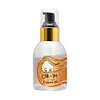What's inside
What's inside
 Key Ingredients
Key Ingredients

 Benefits
Benefits

 Concerns
Concerns

 Ingredients Side-by-side
Ingredients Side-by-side

Cyclopentasiloxane
EmollientDisiloxane
Skin ConditioningDimethicone
EmollientParfum
MaskingArgania Spinosa Kernel Oil
EmollientHippophae Rhamnoides Fruit Oil
Skin ProtectingOenothera Biennis Oil
EmollientMacadamia Ternifolia Seed Oil
EmollientPrunus Amygdalus Dulcis Oil
Skin ConditioningPersea Gratissima Oil
Skin ConditioningHelianthus Annuus Seed Oil
EmollientGlycine Soja Oil
EmollientBixa Orellana Seed Oil
EmollientTocopherol
AntioxidantWater
Skin ConditioningCyclopentasiloxane
EmollientDimethicone
EmollientGlycerin
HumectantHydroxyethyl Acrylate/Sodium Acryloyldimethyl Taurate Copolymer
Emulsion StabilisingPhenoxyethanol
PreservativeParfum
MaskingChlorphenesin
AntimicrobialDimethicone/Vinyl Dimethicone Crosspolymer
Skin ConditioningCaramel
Cosmetic ColorantPEG-14m
Emulsion StabilisingButylene Glycol
HumectantHydrolyzed Silk
HumectantAlcohol
AntimicrobialHydrolyzed Collagen
EmollientPolyacrylate-13
Gelatin
Hydrolyzed Keratin
HumectantAvena Sativa Kernel Extract
AbrasivePolyisobutene
Hydrolyzed Wheat Protein
Skin ConditioningHydrolyzed Soy Protein
HumectantHydrolyzed Corn Protein
Skin ConditioningPolysorbate 20
EmulsifyingBrassica Oleracea Italica Extract
AstringentSolanum Lycopersicum Fruit
EmollientBrassica Oleracea Capitata Juice
Skin ConditioningApium Graveolens Extract
Skin ConditioningDaucus Carota Sativa Root Extract
Skin ConditioningOryza Sativa Extract
AbsorbentSodium Dehydroacetate
PreservativeEthylhexylglycerin
Skin ConditioningBrassica Oleracea Capitata Leaf Extract
Skin ConditioningIllicium Verum Fruit Extract
PerfumingCaprylyl Glycol
Emollient1,2-Hexanediol
Skin ConditioningWater, Cyclopentasiloxane, Dimethicone, Glycerin, Hydroxyethyl Acrylate/Sodium Acryloyldimethyl Taurate Copolymer, Phenoxyethanol, Parfum, Chlorphenesin, Dimethicone/Vinyl Dimethicone Crosspolymer, Caramel, PEG-14m, Butylene Glycol, Hydrolyzed Silk, Alcohol, Hydrolyzed Collagen, Polyacrylate-13, Gelatin, Hydrolyzed Keratin, Avena Sativa Kernel Extract, Polyisobutene, Hydrolyzed Wheat Protein, Hydrolyzed Soy Protein, Hydrolyzed Corn Protein, Polysorbate 20, Brassica Oleracea Italica Extract, Solanum Lycopersicum Fruit, Brassica Oleracea Capitata Juice, Apium Graveolens Extract, Daucus Carota Sativa Root Extract, Oryza Sativa Extract, Sodium Dehydroacetate, Ethylhexylglycerin, Brassica Oleracea Capitata Leaf Extract, Illicium Verum Fruit Extract, Caprylyl Glycol, 1,2-Hexanediol
 Reviews
Reviews

Ingredients Explained
These ingredients are found in both products.
Ingredients higher up in an ingredient list are typically present in a larger amount.
Cyclopentasiloxane, or D5, is a silicone used to improve texture of products and trap moisture.
D5 is considered lightweight and volatile. Volatile means it evaporates quickly after application. Once evaporated, D5 leaves a thin barrier that helps keep skin hydrated.
It is also an emollient. Emollients help soften the skin and prevent water loss. Silicones create a silky texture in products. D5 helps other ingredients become more spreadable.
Studies show D5 is safe to use in skincare products. We recommend speaking with a skincare professional if you have concerns.
Learn more about CyclopentasiloxaneDimethicone is a type of synthetic silicone created from natural materials such as quartz.
What it does:
Dimethicone comes in different viscosities:
Depending on the viscosity, dimethicone has different properties.
Ingredients lists don't always show which type is used, so we recommend reaching out to the brand if you have questions about the viscosity.
This ingredient is unlikely to cause irritation because it does not get absorbed into skin. However, people with silicone allergies should be careful about using this ingredient.
Note: Dimethicone may contribute to pilling. This is because it is not oil or water soluble, so pilling may occur when layered with products. When mixed with heavy oils in a formula, the outcome is also quite greasy.
Learn more about DimethiconeParfum is a catch-all term for an ingredient or more that is used to give a scent to products.
Also called "fragrance", this ingredient can be a blend of hundreds of chemicals or plant oils. This means every product with "fragrance" or "parfum" in the ingredients list is a different mixture.
For instance, Habanolide is a proprietary trade name for a specific aroma chemical. When used as a fragrance ingredient in cosmetics, most aroma chemicals fall under the broad labeling category of “FRAGRANCE” or “PARFUM” according to EU and US regulations.
The term 'parfum' or 'fragrance' is not regulated in many countries. In many cases, it is up to the brand to define this term.
For instance, many brands choose to label themselves as "fragrance-free" because they are not using synthetic fragrances. However, their products may still contain ingredients such as essential oils that are considered a fragrance by INCI standards.
One example is Calendula flower extract. Calendula is an essential oil that still imparts a scent or 'fragrance'.
Depending on the blend, the ingredients in the mixture can cause allergies and sensitivities on the skin. Some ingredients that are known EU allergens include linalool and citronellol.
Parfum can also be used to mask or cover an unpleasant scent.
The bottom line is: not all fragrances/parfum/ingredients are created equally. If you are worried about fragrances, we recommend taking a closer look at an ingredient. And of course, we always recommend speaking with a professional.
Learn more about Parfum